In the intricate landscape of international maritime trade, the Bill of Lading (B/L) functions as a critical legal and logistical instrument, simultaneously acting as a receipt of goods, a contract of carriage, and a document of title. Mastery of its roles, variations, and regulatory implications is essential for ensuring compliance, minimizing risks, and facilitating seamless global shipping operations, particularly under Vietnam’s evolving trade framework.
This article outlines essential aspects of the Bill of Lading in Vietnam to provide businesses with a clearer understanding of its principles and practical applications. We specialize in company formation and do not offer legal or financial advice. For tailored strategies or compliance-related matters concerning Bills of Lading, please consult a qualified legal or logistics expert.
What is a Bill of Lading?
A Bill of Lading is a legally binding document issued by a carrier to a shipper confirming the receipt of goods for transportation by sea. This fundamental document serves as a key legal instrument in maritime commerce, establishing the legal relationship between all parties involved in the shipping process. The B/L is essentially a contract that binds the carrier to transport goods from the port of loading to the designated destination port under specified terms and conditions.
The document represents a crucial component in international shipping, primarily in maritime transport, where goods traverse vast distances across multiple jurisdictions. A B/L simultaneously serves three primary functions: It acts as a receipt for goods, functions as a contract of carriage, and operates as a document of title. This tri-functional nature makes the Bill of Lading indispensable in facilitating secure, efficient, and legally compliant international trade transactions.
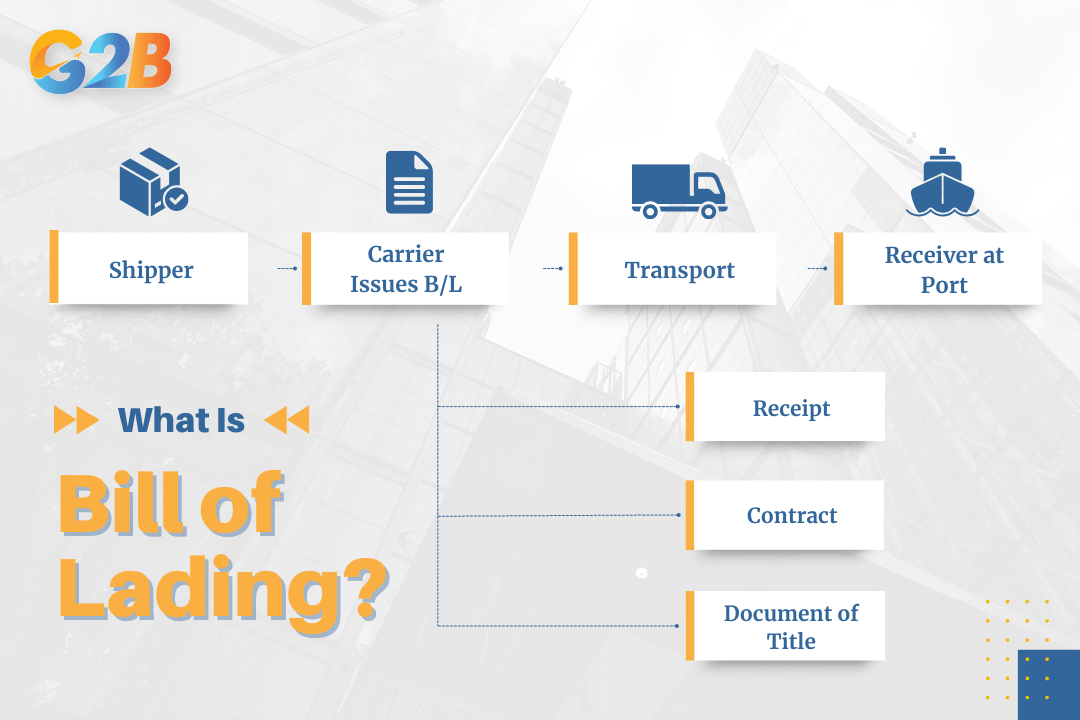
A Bill of Lading is a legally binding document issued by a carrier to a shipper confirming the receipt of goods for transportation by sea
What are the functions of a Bill of Lading?
The Bill of Lading serves eight main functions that are essential for the smooth operation of international maritime trade. Each function plays a critical role in ensuring transparency, security, and legal compliance throughout the shipping process.
1. Receipt confirmation
The Bill of Lading serves as a formal receipt issued by the carrier to the shipper, confirming that the goods described have been received in the specified quantity and apparent condition. This function provides immediate verification of cargo handover.
2. Contract of carriage
It acts as evidence of the contract between the shipper and the carrier, outlining the terms and conditions of transportation, including destination, freight payment terms, and responsibilities of both parties involved in the shipping arrangement.
3. Document of title/proof of ownership
The B/L is a document of title enabling the transfer of ownership of the goods. It can be transferred to third parties, enabling the holder of the original document to claim possession of the goods. This function is critical in international trade, where goods may change ownership multiple times during transit.
4. Customs and regulatory documentation
It provides necessary details for customs clearance and compliance with import/export regulations, facilitating smooth processing at borders and ensuring adherence to international trade requirements and local customs procedures.
5. Facilitates payment and financing
The B/L is often used in financial transactions such as letters of credit (L/C), ensuring exporters receive payment upon delivery and providing security for trade financing arrangements between banks and trading partners.
6. Proof of contract terms and dispute resolution
It documents the agreed terms of shipment, serving as legal evidence in case of disputes over shipment conditions, quantity, delivery, or contractual obligations, providing a clear reference point for resolving conflicts.
7. Tracking and transparency
Facilitates transparency in shipment details and parties involved, but does not directly provide tracking.
8. Insurance purposes
Acts as evidence for insurance claims in case of damage or loss during transit, supporting assessment of claims and providing insurers with detailed information about the cargo and shipping conditions.
How to classify Bills of Lading in maritime shipping?
Bills of Lading are crucial documents in international trade, particularly in maritime shipping. Understanding their classification is essential for smooth logistics and compliance. Here's a comprehensive breakdown of how bills of lading are categorized across different criteria:
1. Classification by consignee (party receiving goods)
- Straight Bills of Lading are non-negotiable documents made out to a specific named consignee, with only the named individual or entity able to claim the goods.
- Order Bills of Lading are negotiable documents that can be transferred to another party, typically "to order" of a specific party or bank, allowing for endorsement and transfer.
- Bearer Bills of Lading are also negotiable but do not name a specific consignee, making the holder entitled to take possession of the goods.
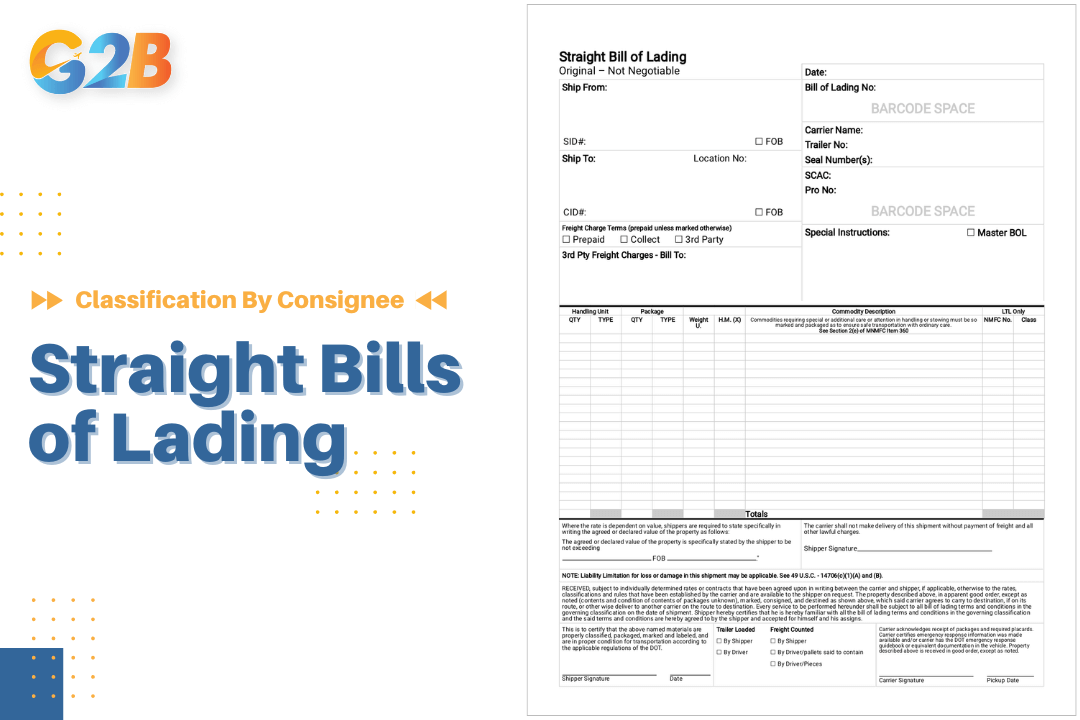
Example template of Straight Bills of Lading
2. Classification by notations on the Bill of Lading
- Clean Bill of Lading (Clean B/L) is issued when goods are received for shipment in apparent good order and condition, with no reservations or notations regarding the condition of the goods or packaging.
- Unclean Bill of Lading (Unclean B/L) or Foul Bill of Lading is issued when the carrier notes any defects, damage, or discrepancies in the goods or their packaging on the bill of lading.
3. Classification by receipt of goods status
- Shipped on Board Bill of Lading (Shipped on Board B/L) is issued after goods have been loaded onto the vessel, often preferred by buyers as it confirms shipment has occurred.
- Received for Shipment Bill of Lading (Received for Shipment B/L) is issued when the carrier acknowledges receipt of goods for shipment, but they have not yet been loaded onto the vessel.
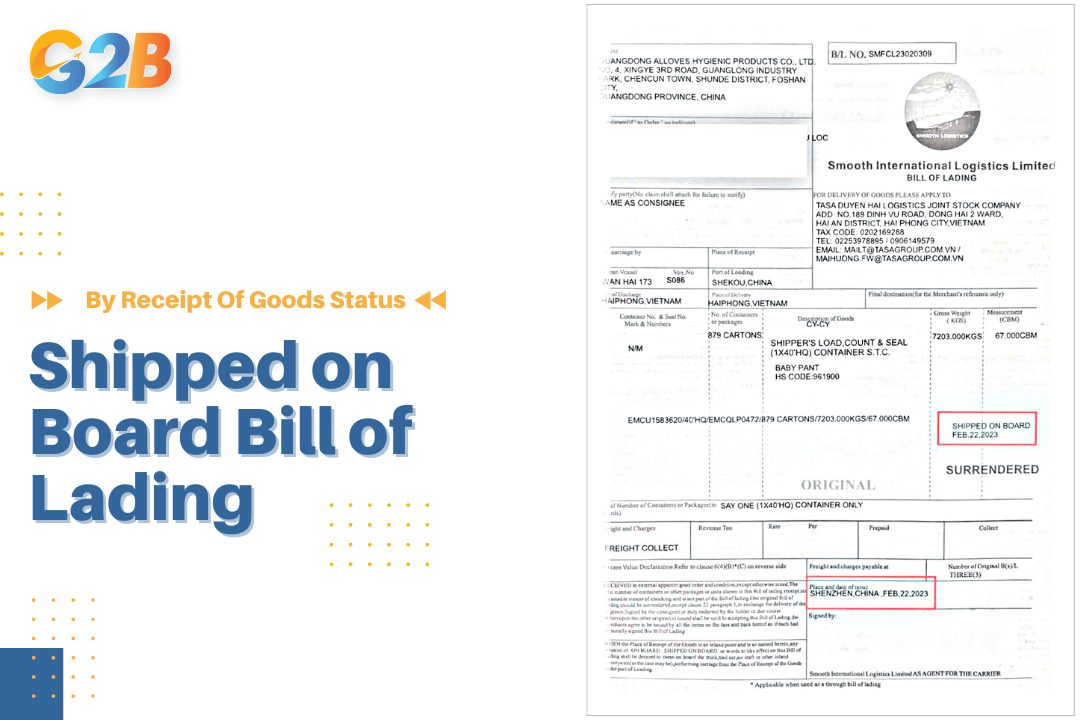
Example template of Shipped on Board Bill of Lading
4. Classification by issuing party
- Master Bill of Lading (MBL) is issued by the actual carrier (such as a shipping line) to the freight forwarder, establishing the primary contractual relationship.
- House Bill of Lading (HBL) is issued by the freight forwarder to the actual shipper, creating a secondary level of documentation in the shipping chain.
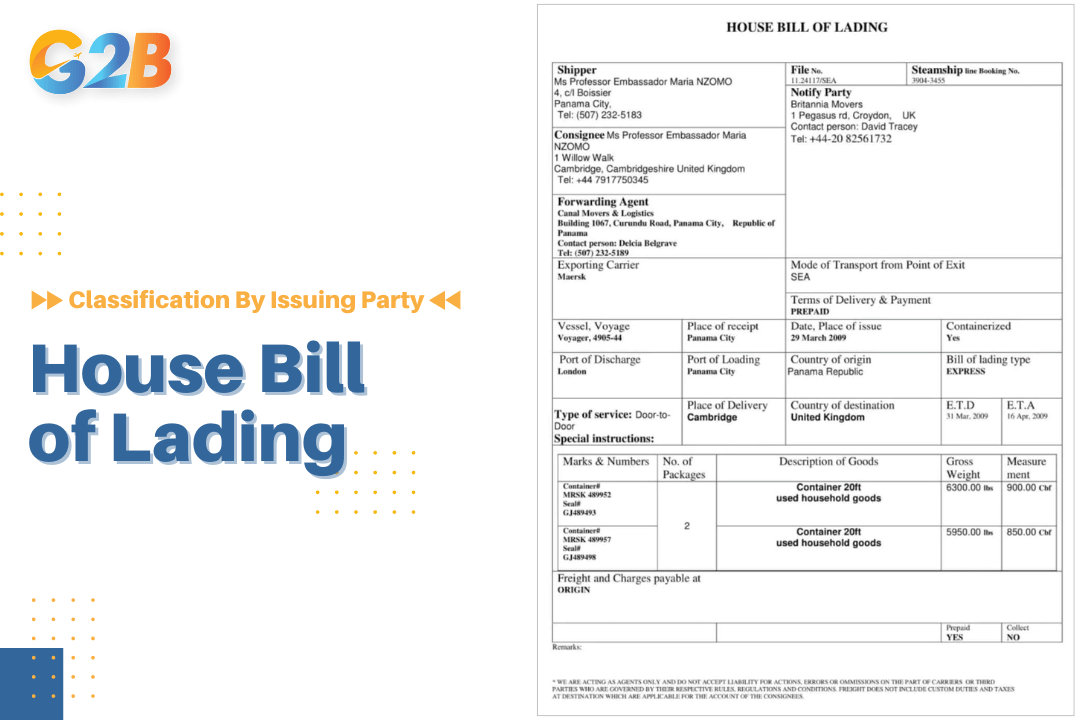
Example template of House Bill of Lading (HBL)
5. Classification by presentation method
- Original Bill of Lading (Original B/L) consists of a set of negotiable documents that must be presented to the carrier or their agent to take delivery of cargo, typically issued in triplicate.
- Telex Release (Electronic Release) authorization sent via telex or email from the shipping line to the destination agent, authorizing cargo release without requiring surrender of original B/Ls.
- Surrendered Bill of Lading (Surrendered B/L) is an original bill that has been surrendered to the carrier at the load port, usually in exchange for a telex release.
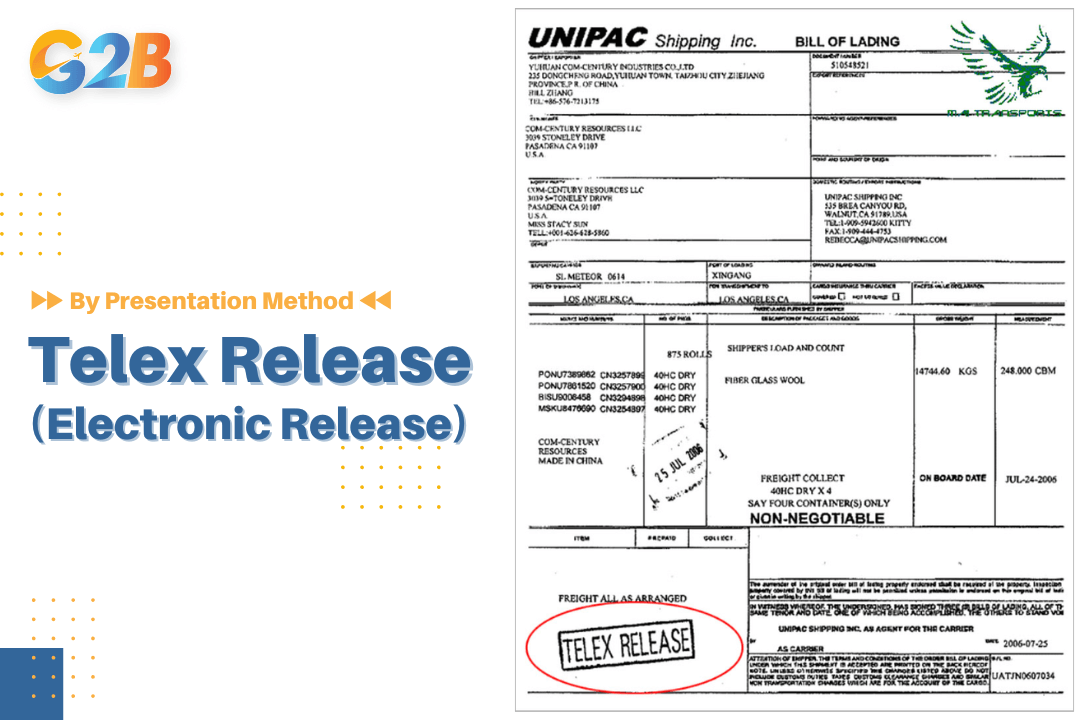
Example template of Telex Release (Electronic Release)
6. Classification by chartering method
- Liner Bill of Lading is used for shipments on vessels operating on a regular schedule (liner service), providing standardized terms and conditions.
- Voyage Charter Bill of Lading is used for shipments on vessels chartered for a specific voyage, often with customized terms reflecting the charter party agreement.
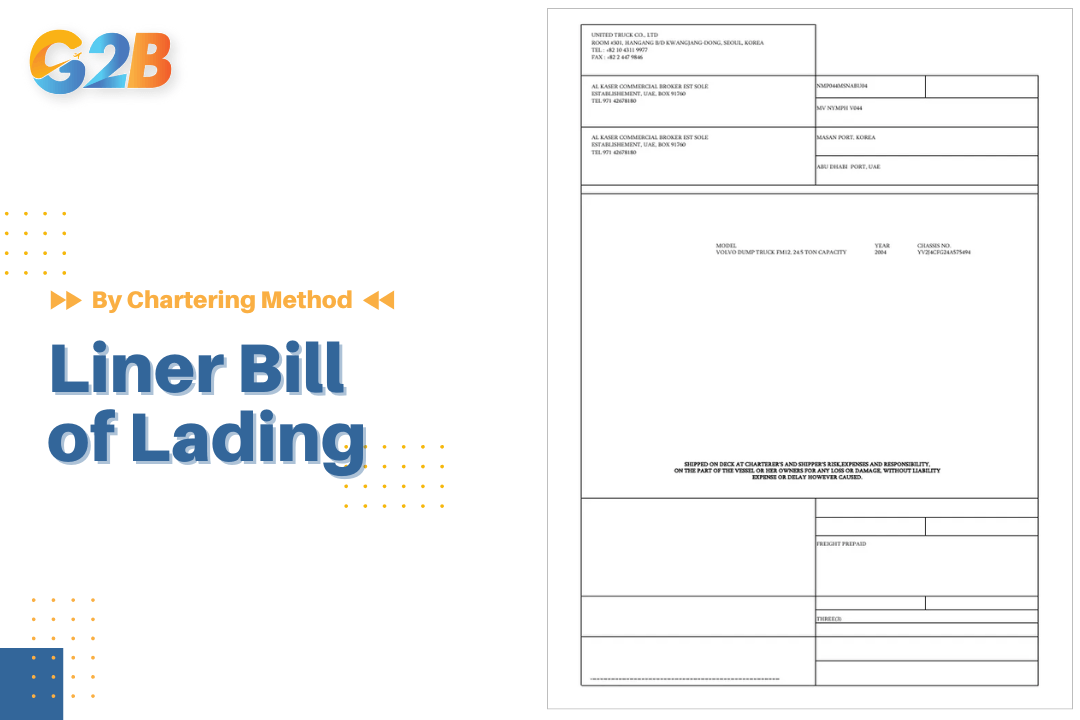
Example template of Liner Bill of Lading
7. Classification by route and transport method
- Direct Bill of Lading covers a direct shipment from the port of loading to the port of discharge without any transhipment, providing the most straightforward shipping arrangement.
- Through Bill of Lading covers a shipment from origin to final destination, which may involve transhipment or multimodal transport.
- Combined Transport Bill of Lading (also known as Multimodal Bill or Intermodal Bill) covers the carriage of goods by at least two different modes of transport from a place of acceptance to a designated delivery location.
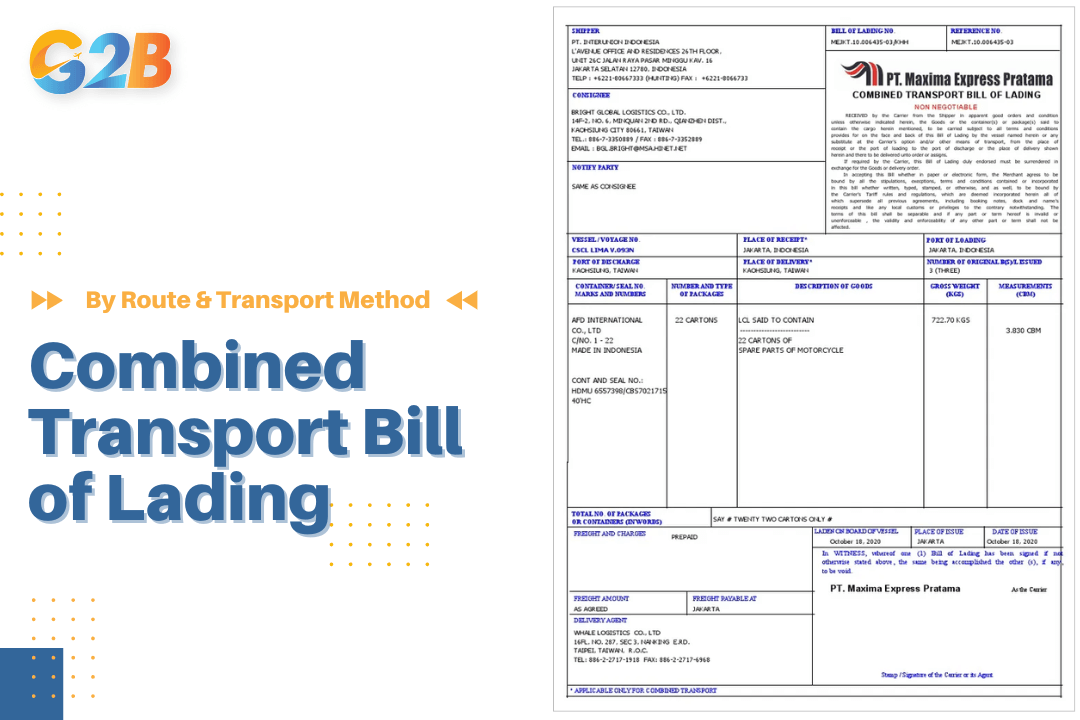
Example template of Combined Transport Bill of Lading
The 03 most important types of Bills of Lading
Among the various types of maritime bills of lading mentioned above, three stand out as particularly significant due to their impact on cargo release and transferability. These are the Original Bill of Lading, the Surrendered Bill of Lading, and the Seaway Bill.
Original Bill Of Lading
The Original Bill of Lading is issued by the carrier or their agent (such as a shipping line), typically as a set of three original documents marked as "First Original," "Second Original," and "Third Original," along with three non-negotiable copies. To take possession of the cargo, the consignee must present at least one of these original bills at the destination.
Pros:
- Provides maximum security and legal protection
- Serves as a negotiable document of title
- Enables cargo financing and letter of credit transactions
- Offers clear proof of ownership
Cons:
- Risk of document loss or delay in transit
- Higher courier costs for document delivery
- Potential delays in cargo release
- Complex handling requirements
Surrendered Bill of Lading
A Surrendered Bill of Lading, associated with a Telex Release authorization, offers significant convenience for both the shipper and the consignee in the process of cargo delivery. This type of bill effectively addresses and overcomes the logistical challenges and potential delays associated with the Original Bill of Lading, such as the time it takes to courier the physical documents.
Pros:
- Faster cargo release process
- Eliminates the risk of document loss
- Reduces courier costs
- Simplified documentation handling
Cons:
- Limited negotiability
- Not suitable for letter of credit transactions
- Reduced security compared to the original B/L
- Requires trust between parties
Seaway bill
A Seaway Bill is a document issued by the shipping line or freight forwarder to the shipper once all costs related to the shipment have been fully paid. Unlike an Original B/L, a Seaway Bill is issued as a single, non-negotiable document, and no original copies are produced. Critically, a Seaway Bill is not a document of title, meaning it does not represent ownership of the goods.
Pros:
- Fastest cargo release method
- No risk of document loss
- Cost-effective solution
- Simplified processes
Cons:
- Cannot be used for financing
- Not negotiable
- Limited legal protection
- Restricted to straight shipments only
The relationship between these three types of Bills of Lading
Understanding the key distinctions and relationships between the three types of bills described above is crucial for effective maritime shipping operations:
- Issuance: For a Surrendered B/L, a set of Original Bills is first issued and then immediately collected (surrendered) at the load port. In contrast, a Seaway Bill is created without any original set being issued at all.
- Release Method: The cargo release mechanism for a Surrendered B/L is a "Telex Release." For a Seaway Bill, the method is known as an "Express Release."
- Document of Title: The Original Bill of Lading is a document of title, meaning it represents ownership of the goods and is negotiable. Neither the Seaway Bill nor the Surrendered Bill of Lading is considered a document of title.
Bill of Lading in Vietnam
This section explores the legal foundations, common formats, types, and regulatory practices surrounding B/Ls in Vietnam, offering essential insights into how these documents are controlled and utilized across the country's shipping industry.
1. Legal basis and applicable regulations in Vietnam
In Vietnam, the Bill of Lading (B/L) is regulated in detail by the Vietnam Maritime Code 2015, in conjunction with international conventions such as the Hamburg Rules (United Nations Convention on the Carriage of Goods by Sea, 1978), to which Vietnam is a signatory. This comprehensive legal framework ensures that Vietnamese maritime practices align with international standards while addressing local regulatory requirements.
Mandatory information on a B/L in Vietnam is specified in Article 160 of the Maritime Code, including details such as the carrier's name, shipper, consignee, vessel name, cargo description, port of loading and discharge, number of original B/Ls, and the signature of an authorized person. Internationally, B/Ls follow similar conventions, but each country may have additional regulations tailored to its local legal framework - for example, stricter documentation and carrier liability requirements in the EU or the US. Vietnam's regulatory environment is relatively more flexible, making it attractive for foreign logistics providers or exporters seeking to register a company in Vietnam and participate in the growing maritime trade sector.
2. Content and format of the B/L in Vietnam
Vietnam's B/Ls generally adhere to international standards but may include additional details required by local customs, maritime, and logistics authorities. This ensures compliance with both international trade practices and Vietnamese regulatory requirements. The format typically includes comprehensive cargo descriptions, detailed routing information, and specific terms and conditions that reflect Vietnamese maritime law.
Some shipping lines in Vietnam use customized B/L formats (such as Master Bills from MCC, SITC, OOCL, etc.) that align with international conventions but may differ in language or presentation. Globally, most B/Ls follow standardized templates issued by the Baltic and International Maritime Council (BIMCO) or other international trade organizations, ensuring consistency across different jurisdictions.
3. Format of the B/L in Vietnam
In Vietnam, B/Ls are still primarily issued in traditional paper format, although there is gradual development and pilot projects toward electronic Bills of Lading (e-B/Ls) to increase transparency and reduce paperwork and costs. This digital transformation is part of Vietnam's broader initiative to modernize its maritime infrastructure and align with global digitalization trends.
The transition to electronic documentation offers significant advantages, including reduced processing times, enhanced security features, and improved tracking capabilities. Worldwide, e-B/Ls are increasingly adopted, especially in trade between developed countries, helping improve processing speed and data security while reducing the environmental impact of paper-based documentation.
4. Common types of Bills of Lading in Vietnam
In Vietnam, commonly used B/Ls include: Original B/L, Order B/L, Straight B/L, and Bearer B/L, which align with international norms and facilitate various types of trade transactions. Each type serves specific purposes depending on the nature of the cargo, the relationship between trading parties, and the financing arrangements involved.
In addition, Master Bills and House Bills are also widely used in coordination with carriers and international freight forwarders, creating a comprehensive documentation system that supports complex supply chain operations. These B/L types all fulfill the core functions of a receipt, contract of carriage, and document of title, consistent with global standards while meeting Vietnamese regulatory requirements.
5. Control and management of B/Ls in Vietnam
Vietnam enforces strict regulations on B/L issuance, signing authority, and handling of invalid documents to prevent fraud and protect the interests of all parties involved in maritime transactions. The regulatory framework includes comprehensive oversight mechanisms that ensure document authenticity and prevent unauthorized modifications or duplications.
The B/L verification process for import/export customs clearance involves close coordination among carriers, forwarders, ports, and customs authorities, creating a robust system of checks and balances. This multi-layered approach helps maintain the integrity of the documentation process while facilitating efficient cargo clearance procedures.
Globally, similar B/L management mechanisms exist, though some countries have more advanced electronic systems that integrate with digital customs platforms, enabling real-time verification and automated processing capabilities that Vietnam is gradually adopting.
6. Maritime transport market and role of the B/L
In Vietnam, domestic shipping fleets handle approximately 7% of import/export cargo volume, with the remaining 93% managed by foreign carriers. This distribution significantly affects the issuance and control of B/Ls by local companies compared to international practices, creating unique challenges and opportunities in the Vietnamese maritime sector.
The dominance of foreign carriers in Vietnam's maritime trade means that most B/Ls are issued according to international standards and procedures, while local carriers must adapt to both Vietnamese regulations and international requirements. This dual compliance requirement ensures that Vietnamese maritime operations remain competitive in the global marketplace while maintaining adherence to local legal frameworks.
Globally, major carriers issue B/Ls based on standardized international procedures, enabling smoother global trade operations and facilitating seamless integration between different maritime systems and regulatory environments. Vietnam's participation in this global network ensures that its maritime sector remains connected to international trade flows while developing its domestic capabilities.
The Bill of Lading is one of the most critical documents in international maritime trade, serving multiple essential functions that enable secure, efficient, and legally compliant shipping operations. From its fundamental role as a receipt for goods to its sophisticated function as a negotiable document of title, the B/L facilitates billions of dollars in global trade transactions daily.


 Delaware (USA)
Delaware (USA)  Vietnam
Vietnam  Singapore
Singapore  Hong Kong
Hong Kong  United Kingdom
United Kingdom 
